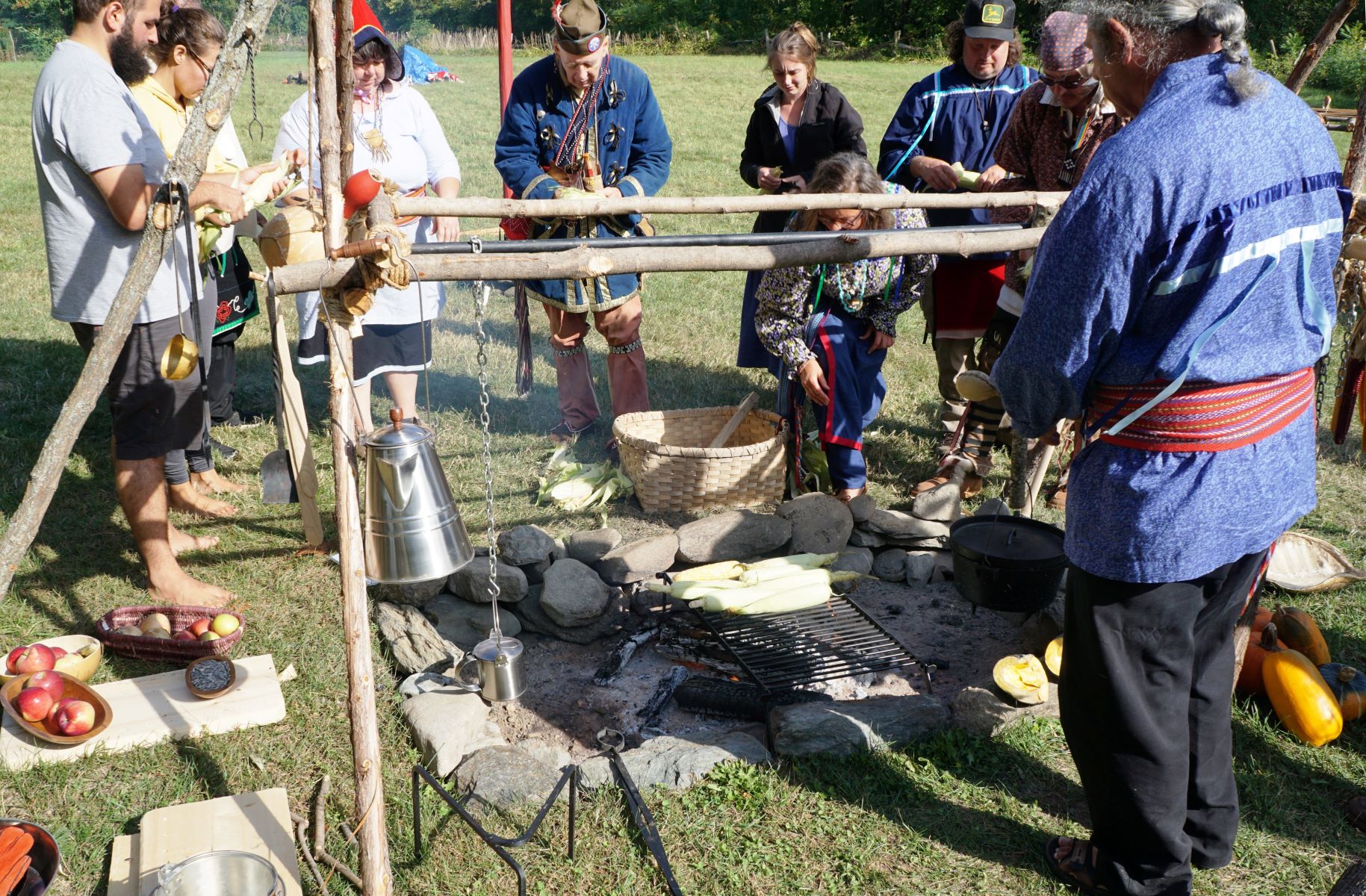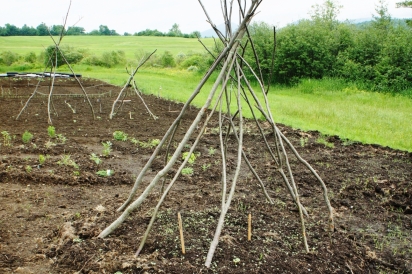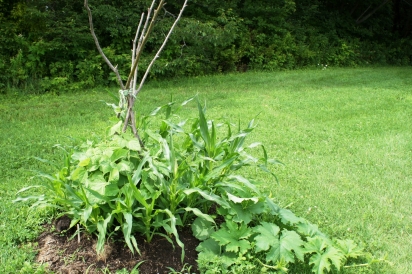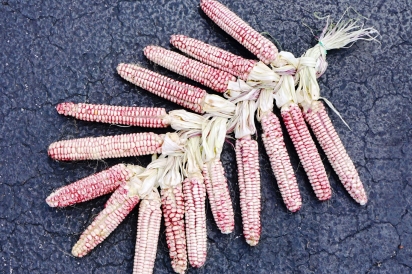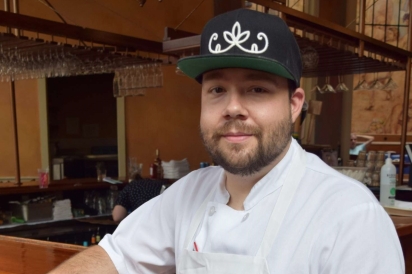TRIBAL TRADITIONS: UPDATED CUISINE
Perhaps you’re familiar with the Abenaki tradition of companion planting the “Three Sisters”: corn, beans, and squash. But did you know that the family actually includes four more siblings—sunflowers, Jerusalem artichokes (sunchokes), ground cherries, and tobacco—and a few cousins: wild rice, groundnuts, and wild leeks (ramps)?
Dr. Fred Wiseman, a Missisquoi Abenaki from northwestern Vermont and director of the Seeds of Renewal project, believes that Abenaki knowledge such as this should be commonplace throughout Vermont.
The Abenaki have lived in Vermont for more than 10,000 years, and tribal leaders want to make it known to the general population that the Abenaki are present and thriving. Chief Don Stevens of the Nulhegan Abenaki and Wiseman have dedicated years of energy and political activism to help four tribes (Nulhegan, Missisquoi, Koasek, and Elnu) achieve official recognition from the state of Vermont, which was granted in 2011/2012 in part after documenting and proving that their people had in fact lived continuously in Vermont.
One of the most effective ways to understand the persistence of the Abenaki is through agriculture. Wiseman and his fellow tribal leaders revive and teach traditional songs, rituals, and dances associated with the seasonal indigenous agricultural ceremonies, including the Green Corn ceremony and a variety of planting rituals and harvest festivals. They also study and reintroduce Abenaki growing practices such as companion planting and various mound systems rather than beds or rows.
Wiseman began working with Vermont’s indigenous communities in 1993 to record their cultural, geographic, and historical information. As an ethnobotanist, he discovered ancient agricultural engineering and horticultural techniques still being practiced by Abenaki farmers in northern Vermont and the Connecticut River Valley. Visits with farmers revealed rare and supposedly “lost” indigenous crops still growing on hill farms or spreading wild along valley riverbanks. Wiseman began to collect these rare seeds and to deposit them safely in one place. In 2012, he founded the Seeds of Renewal project, a grassroots coalition of partners throughout northern New England and eastern Canada. Its mission is to assist and encourage the Abenaki tradition of seed saving and indigenous gardening by helping to track down rare or long-lost seeds native to this region.
By 2013, Wiseman had gathered 14 crop varieties; by 2020, he had amassed more than 55. An experienced gardener himself, Wiseman knew the seeds had to be planted or properly conserved or else their genetic lineage would be lost forever. That necessitated finding partnering organizations with sufficient land, agricultural knowledge, and commitment to care for the precious seeds.
Sterling College, a Seeds of Renewal partner since 2015, is responsible for propagating all 55 varieties of seeds and keeping them pure, safe from cross-pollination. Wiseman distributes the seeds grown on Sterling’s Craftsbury campus to other partnering gardens. The Abenaki Heritage Garden at Burlington’s Intervale Center, Seeds of Renewal’s longest-term partner, also grows large quantities of indigenous produce for ceremonies. The demonstration garden, open to the public, uses traditional methods of mounded cultivation and fish fertilizer.
“We just finished our first year working with the UVM Horticultural Gardens off IDX Drive,” Wiseman notes. “We had our biggest harvest of dry beans yet in September, with UVM students engaged in the process. And we had our first good crop of Abenaki Rose corn there as well. That corn is now braided and drying at the Intervale Center. We plan to quadruple our production at the UVM gardens in 2021.”
The Vermont Indigenous Heritage Center at the Ethan Allen Homestead remains the institutional home of the Seeds of Renewal project and a cultural focal point, with its Abenaki living history museum on site. “There’s an 1850 village complete with a wigwam, a crafter’s hut, and a dance ground. We’re planning to create a large mound garden there in 2021. Our hope is to be open for events on several weekends throughout the spring and summer. Next fall, visitors should be able to visit and see Abenaki dressed in period clothing tending crops using traditional handmade tools and equipment and cooking in a large outdoor kitchen. We’ve built a stone-lined bean hole, an essential element in Abenaki cuisine.”
“My goal is to solidify the underlying structure of Abenaki cuisine and to gather the old recipes developed by the Abenaki. However, traditional Abenaki cuisine can seem bland by our twenty-first-century tastes. Our palates have come to expect moresalt and fat. Jessee Lawyer, an Abenaki chef, has been a tremendous resource. He’s working on recipes and modern preparations to make the dishes a bit more appealing while still remaining true to native ingredients.”
Since they’ve started to improve some of the recipes, Wiseman has noticed that at ceremonial potlucks, guests are now going back for seconds. And the crockpots are empty at the end.
Jessee Lawyer—Bringing Abenaki Cuisine into the Twenty-first Century
Jessee Lawyer, the executive chef at Sweetwaters Bistro in Burlington, is developing twenty-first-century recipes to update indigenous dishes while maintaining their authenticity.
Traditional indigenous cuisine involves no pork, beef, dairy, or flour. Rather, it centers on wild game, fish, nuts, seeds, berries, and native vegetables. A Missisquoi Abenaki, Jessee remains quietly focused on one goal. “I really want to get Abenaki people cooking indigenous food, so I’m steadily developing recipes that will help them use the corn, beans, squash, wild game, and anything foraged.”
“Although I’m an indigenous chef,” he explains, “I do use modern techniques and some post-contact ingredients that were introduced to the Americas after Columbus arrived. There’s a big push in native cuisine for decolonization, and a lot of chefs only cook pre-contact ingredients. But others cook whatever they feel using the ingredients they want. And that’s the direction I’m leaning: keeping indigenous foods at the center of the plate and building the flavors I want using butter and cream, which aren’t native, to make that achievable. The food has to taste good if you want people to eat it!”
Jessee grew up in Richford, Vermont, two miles from the Canadian border. He began his culinary career at a pizza shop in Plattsburgh, New York, then landed a job as a fry cook at Sweetwaters in June 2013. He became sous chef in 2015 and advanced to executive chef
in 2017. Jessee now oversees a team of 25. “Cooking is creative and satisfying. I never stop learning, and who doesn’t love to play with knives and fire?”
In his rare free time, Jessee produces traditional Abenaki art. “My dad carved pipes and made moccasins. I also focus on functional pieces. Pipes, ceremonial regalia, items related to food harvesting and procurement such as bow and arrows, a moose call, duck decoys, fish spears, and storage baskets. I try to make them as elaborate as my hands will allow.”
Jessee took a renewed interest in his heritage about 10 years ago. “My dad introduced me to Fred Wiseman at a Missisquoi Tribal Council meeting in 2015. Fred encouraged me to take a more active role with native cuisine. I’m not much of a recipe guy; I cook more by instinct. So I started to play around and experiment with native ingredients. I’m constantly learning and tracking down new ‘old’ ingredients. I see something, take a picture, send it out among people who do know, and ask ‘Can I eat this and how could I cook it?’ The Sioux Chef’s Indigenous Kitchen by Sean Sherman is my bible for the broad scope of indigenous cuisine. And Fred Wiseman’s book Seven Sisters is a fantastic guide to Abenaki horticulture.”
“This is my next adventure,” Jessee continues, “figuring out what can I eat from the land around me. There are so many indigenous ingredients native to Vermont. Elderberries, wood sorrel, wild mushrooms, nuts, fish, anything that walks or crawls—deer, moose, beaver, squirrel, rabbit. I hunt and fish. I’m not great, but I enjoy being in the woods or on the water. My goal is to be self-sustainable, to nourish myself and my family.”
Jessee recommends that people looking to cook more native-style meals this winter should start with stews. Venison or moose stew (you can swap in short ribs or stew beef) with potatoes, squash, carrots, onions, celery, tomatoes, red wine, salt, and pepper. “Just braise it low and slow. Keep things simple to let the natural flavors shine through.” And he notes that winter fish, such as perch, Northern pike, and walleye, are also perfect for frying or grilling.
“Winter squash baked on an open fire is my favorite. East Montpelier squash is similar to a Blue Hubbard. It’s sweet and succulent on its own and doesn’t need any seasoning or butter. I love open-fire cooking. When I buy a house in the spring, I’m going to put more money into my outdoor kitchen than in my indoor one for sure.”
In early fall, Jessee invited me to Sweetwaters where he prepared a beautiful meal made of indigenous ingredients, all locally sourced. Confit duck leg, white scallop squash purée with elderberry syrup, roasted hominy, sautéed huitlacoche (corn mushroom), and sunflower shoots. Before we savored the autumnal feast, he explained the dish’s preparation.
“I cured the duck legs in kosher salt, maple sugar, dried sumac, sweet fern, and crushed juniper berries. Then I dry-aged them in the refrigerator for a week. I roasted them at low heat for three hours in their own rendered fat and crisped the skin in a hot skillet just before serving.”
“The white scallop squash was slow-cooked in the duck fat, then puréed with cream, maple sugar, dried sumac, sweet fern, and butter. The elderberry syrup came from berries I picked in my own backyard. I cooked them down with a bit of water, pushed the mash through a fine strainer to remove the seeds that can be bitter, and added some maple syrup.”
“Hominy is a dent corn, not sweet corn. All Souls Tortilleria in Burlington nixtamalized, or processed, the corn with lime to remove the outer kernel. I tossed the kernels in duck fat, maple sugar, sumac, and salt and roasted them on a sheet pan at 400 degrees for about 30 minutes. Roasted hominy adds crunchy texture to any dish. You can get hominy fresh, dried, or canned at City Market.”
“Huitlacoche is a real treat. It’s a specialty in Mexican cuisine, and the Dakota tribe out West revered it as well. Huitlacoche is actually a fungus that grows on organic corn indigenous to the Americas, and I was psyched to have the opportunity to use it for this dish. Funj Shrooming Company in Saint Albans sourced it for me. It looks and tastes similar to roasted wild mushrooms. You can use any meaty wild mushrooms and sauté them in duck fat and salt. And the sunflower shoots were grown at Queen City Acres in Burlington. Sunflowers are one of the Seven Sisters in Abenaki food culture.”
“I just threw a bunch of flavors together. Let’s see if it actually worked!” he said, laughing, as we reached for our forks and knives.
It did.


